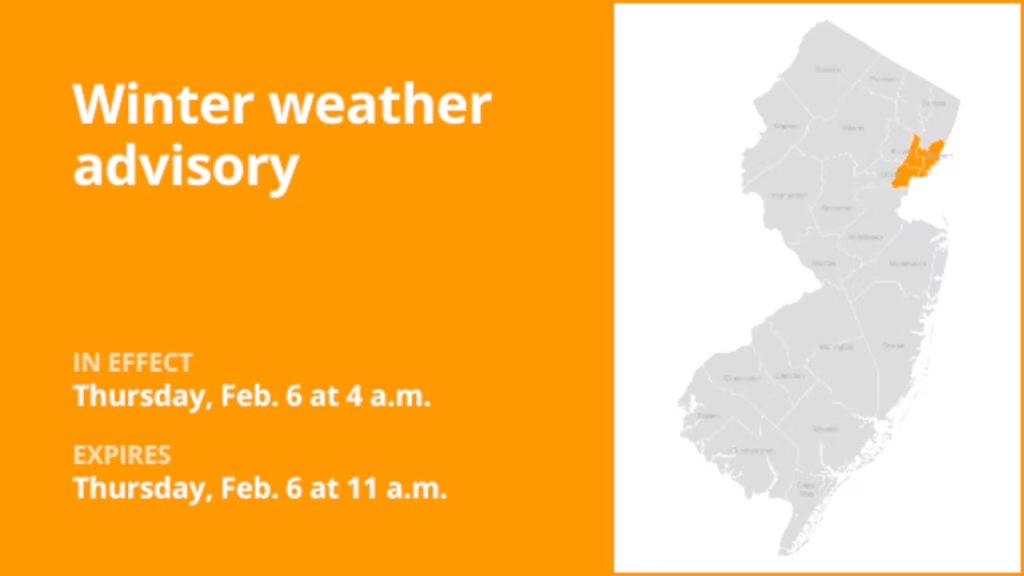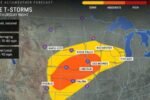The National Weather Service (NWS) has issued an updated winter weather advisory early this morning for Hudson, Essex, and Union counties in New Jersey. The advisory, released at 5:38 a.m. on Wednesday, is valid for Thursday between 4 a.m. and 11 a.m. This alert warns residents that a mix of precipitation is expected to impact the region during the morning commute, creating potentially hazardous road conditions.
What to Expect on Thursday Morning
According to the advisory, a mix of precipitation will begin as snow early on Thursday. As the morning progresses, the weather will shift to a wintry mix of snow, sleet, and freezing rain. In some areas, there could be a glaze of ice on roads, sidewalks, and driveways. Total snow and sleet accumulations are expected to be around one inch, accompanied by a thin layer of ice.
As temperatures gradually rise above freezing by late morning, the wintry mix will change to plain rain. This transition may lead to varying conditions on the roads and other surfaces, making it difficult to predict exactly when the change will occur. The National Weather Service urges all residents to check local transportation updates and weather reports frequently to stay informed about the latest conditions.
Impact on the Morning Commute
The winter weather advisory comes at a time when many residents are preparing for their Thursday morning commute. The hazardous conditions—caused by mixed precipitation and icy patches—are expected to make driving treacherous. The advisory specifically warns drivers to slow down and exercise extra caution while on the road.
The early hours of the morning are critical because road conditions can change quickly, and even a small accumulation of ice can make surfaces extremely slippery. With the precipitation expected to begin as snow and then transition into sleet and freezing rain, drivers must be prepared for sudden changes. This makes the morning commute particularly challenging.
Safety Tips for Driving in Winter Weather
The National Weather Service has provided several practical tips for those who need to travel during hazardous winter weather. Here are some expert recommendations to help keep you safe on the roads:
- Reduce Your Speed:
Slower speeds give you more time to react if the roads become slick. In near-freezing conditions, it is best to assume that all roads may be icy, so adjusting your speed accordingly is essential. - Increase Following Distance:
When driving on slippery roads, maintain a greater distance between your vehicle and the car in front. This extra space will allow for longer stopping distances and reduce the risk of a collision. - Use Headlights Wisely:
Turning on your low-beam headlights (and not high beams) can help you see better in the mixed precipitation. High beams can reflect off the precipitation and reduce visibility even further. - Plan Your Route:
Consider routes that are less likely to be affected by heavy snow or ice. Avoid roads with many trees and power lines, as these areas are more prone to ice accumulation. - Keep Your Vehicle Ready:
Before you hit the road, ensure your car is winter-ready. Check your tire pressure, ensure that your windshield wipers are in good condition, and top up your windshield washer fluid. Also, keep an emergency kit in your vehicle with essentials like a blanket, a small shovel, a flashlight, jumper cables, water, and non-perishable food items. - Share Your Travel Plans:
If you must travel during severe weather, let someone know your route and expected arrival time. This precaution can be crucial in case you become stranded and need assistance. - Stay Informed:
Keep an eye on local news and Department of Transportation updates. This information can help you adjust your plans based on the latest weather forecasts and road conditions.
How to Stay Safe When Walking Outside
It’s not just drivers who need to be cautious—pedestrians must also take care during winter weather. Slippery conditions on sidewalks, stairs, and driveways can lead to dangerous falls. Here are some tips for those walking outside:
- Wear Appropriate Footwear:
Choose shoes with good traction to help prevent slips. Consider adding ice grips or using boots designed for winter conditions. - Take Small, Careful Steps:
Walk slowly and deliberately, especially on surfaces that may be covered in ice or snow. Avoid quick movements that could lead to a fall. - Use Handrails and Support:
When available, use handrails on stairs and ramps to maintain your balance. If you are unsure about the condition of a walkway, proceed with extra caution. - Be Mindful of Your Surroundings:
Look ahead to see if there are any areas that appear more slippery than others. Avoid these spots if possible or find a safer path.
What the Advisory Means for Local Communities
The winter weather advisory issued by the National Weather Service is a reminder of the challenges that come with winter weather in New Jersey. For residents in Hudson, Essex, and Union counties, it means staying prepared and vigilant during the morning hours on Thursday.
Local authorities and the Department of Transportation are working to monitor road conditions closely and provide timely updates. However, individual preparation is key. By following the safety tips provided and staying informed about the latest weather developments, residents can reduce the risk of accidents and injuries during the winter storm.
The advisory also serves as an important alert for businesses and schools. Employers may need to adjust work schedules or encourage remote work during severe weather conditions. Schools should consider delaying start times if road conditions are deemed unsafe for students. These measures help ensure that everyone remains safe until conditions improve.
Expert Insights on Winter Weather Preparedness
Experts note that winter weather, especially when mixed precipitation is involved, can be unpredictable. Even a small amount of freezing rain can create slippery conditions that significantly increase the risk of accidents. This is why the National Weather Service emphasizes caution and preparedness during the advisory period.
Local meteorologists are closely monitoring the weather patterns and advise residents to take the forecast seriously. They point out that the transition from snow to freezing rain and eventually to plain rain means that conditions can change rapidly. This unpredictability makes it essential to check for updates frequently and plan accordingly.
Long-Term Tips for Winter Safety
Beyond just the upcoming Thursday advisory, experts recommend that residents adopt long-term strategies for winter safety. These strategies include:
- Regular Vehicle Maintenance:
Keep your vehicle in good working condition throughout the winter months. Regular maintenance can prevent breakdowns and improve your vehicle’s performance in cold weather. - Home Preparedness:
Ensure your home is ready for winter by checking heating systems, insulation, and emergency supplies. Having a well-prepared home can make a big difference during severe weather. - Community Awareness:
Engage with local community groups or neighborhood watch programs that focus on winter safety. Sharing information and resources can help everyone stay safe during extreme weather events. - Education and Training:
Consider taking a winter driving course or attending local safety workshops. These sessions can provide practical tips and techniques for handling slippery roads and other winter hazards.
The Role of Weather Services and Technology
Modern technology plays a crucial role in keeping us safe during winter weather. Weather apps, local news alerts, and online transportation updates provide real-time information that can help residents make informed decisions. The National Weather Service, in particular, works hard to issue timely advisories and forecasts to ensure public safety.
For those who rely on smartphones and other digital devices, signing up for weather alerts and following local transportation departments on social media can be invaluable. These tools allow residents to receive immediate updates on changes in road conditions and weather patterns.
Conclusion
The winter weather advisory affecting Hudson, Essex, and Union counties is a clear reminder of the challenges posed by winter storms. With mixed precipitation expected on Thursday between 4 a.m. and 11 a.m., residents need to be extra cautious during their morning commutes. The combination of snow, sleet, freezing rain, and the transition to rain later in the morning creates unpredictable conditions that can lead to hazardous travel and a higher risk of accidents.
Whether you are driving or walking, taking the necessary precautions can help protect you and your loved ones during these challenging weather conditions. Prepare your vehicle, plan your route, and stay informed through local weather updates and transportation alerts. Remember, safety is the top priority during winter weather, and a few extra precautions can make a big difference.
As communities in Hudson, Essex, and Union counties brace for the storm, let this advisory be a reminder of the importance of preparedness, caution, and community support. Stay safe, drive carefully, and help spread the word so that everyone can be well-informed and ready to face the winter weather together.
Disclaimer – Our editorial team has thoroughly fact-checked this article to ensure its accuracy and eliminate any potential misinformation. We are dedicated to upholding the highest standards of integrity in our content.





More Stories
How the Latest Winter Advisory Affects Your Thursday Commute
How the Latest Winter Advisory Affects Your Thursday Commute
How the Latest Winter Advisory Affects Your Thursday Commute